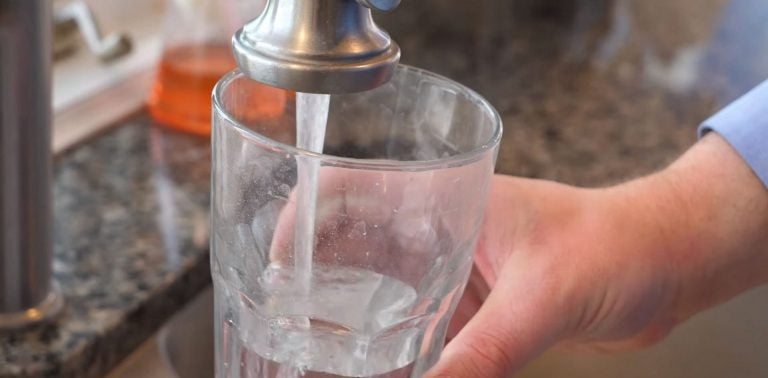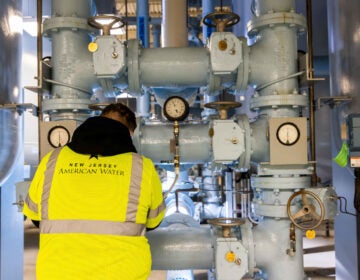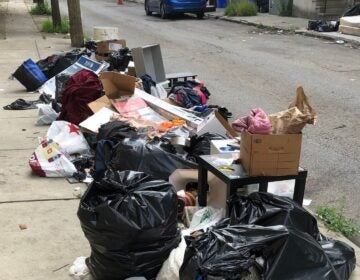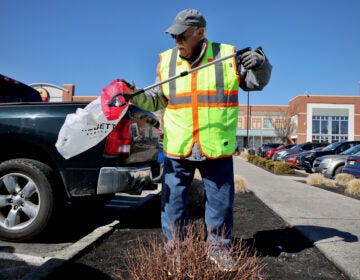PFAS chemicals in drinking water: How one Pa. homeowner took matters into his own hands
The more Nathan Volpi learned about PFAS, a man-made chemical linked to various health conditions that isn’t routinely tested for in drinking water, the more it troubled him.

PFAS are toxic chemicals commonly found in clothing and non-stick cookware like teflon. York County homeowner Nathan Volpi found out getting his water tested was neither easy nor cheap (Wallace McKelvey/PennLive)
The more Nathan Volpi learned about PFAS, a man-made chemical linked to various health conditions that isn’t routinely tested for in drinking water, the more it troubled him.
Three years ago, his growing family moved to northern York County across the Susquehanna River from Harrisburg International Airport, a known source of the toxin commonly found in firefighting foam, nonstick cookware and water-repellant clothing.
Volpi, a Camp Hill-based attorney, started the process of getting his water tested several months ago. It was neither easy nor inexpensive — certainly not feasible for everyone living in high-risk areas — but he didn’t want to take any chance with his 8-month-old son and 3-year-old daughter. According to health experts, children are among the most vulnerable.
“I turned my back one time while [my daughter] was taking a bath and she drank some of the bathwater,” he said. “I had to tell her to stop.”
His first step was to reach out to several labs that processed samples from several of the high-profile contamination sites in southeast Pennsylvania. Those facilities were already overwhelmed but they referred him to the Lancaster branch of ALS Global who, in turn, hired a subcontractor to collect the sample.
There are several web services that will test samples collected by homeowners — one, SimpleWater, charges $249 for a PFAS test — but Volpi wanted to avoid any possible user error or doubts about collection methods.
“They don’t like untrained people doing it,” he said. “It’s very easy to contaminate your sample so you get a false positive or false negative.”
A technician collected a sample — from the bathroom his 8-month-old often uses — and the results came back last month. They showed combined PFAS/PFOA levels of 186 parts per trillion. That’s far beyond the 70 parts per trillion limit established in an EPA health advisory. Recent research, however, indicates that even much smaller concentrations than 70 parts per trillion can be dangerous.
“It was a total bottled-water switch,” Volpi said. “We can’t use our tap water for cooking or drinking. When you bathe in it, you have to make sure you dry off right away. We steam-mop the house usually but you’re not supposed to steam or heat these chemicals so we use bottled water to clean the floor.”
And because scientists are still studying PFAS contamination, there’s a great deal of conflicting information about the safety of brushing one’s teeth with contaminated water, for example.
First developed by 3M in the 1930s and mass-marketed in the ‘40s and ‘50s, these synthetic chemicals—also known as perflourinated chemicals or PFCs—enabled the development of nonstick cookware, water-repellent clothing and firefighting foam. Today, there are thousands of these chemicals known by acronyms like PFOS, PFOA, PFNA and PFHxS.
But the chemical bonds that give PFAS their heat, oil and water-resistant qualities are so resilient they don’t break down in the environment — or in the human body. It didn’t take long for PFAS to make their way into drinking water and, finally, the human bloodstream. They’ve been linked to various health effects, including pregnancy complications and problems related to the liver, lungs and thyroid.
Volpi was left somewhat conflicted by the knowledge that his own water had elevated levels of the chemical. He knew he was going to tell his neighbors but what was his responsibility to the wider world?
“I wasn’t going to keep this to myself,” he said.
Volpi called Gov. Tom Wolf’s new PFAS task force and found himself being transferred from one phone number to another. He left a voicemail that went unreturned. Then, he called the state Department of Environmental Protection, the agency responsible for ensuring safe drinking water standards. The DEP, in turn, forwarded his test results to Suez Water, the utility that serves Newberry Township.
From the vantage point of a customer, he said, the process seemed unnecessarily long and arduous.
Suez initially told Volpi that they wanted to collect their own sample from his home. Then, they informed him that they were working with the DEP to respond but would have to wait until an April meeting to start a new granulated activated carbon treatment system to remove PFAS from the township’s water.
“I have an infant and a toddler and I know my water’s contaminated,” he said. “My test was back in March … I told them I couldn’t wait anymore.”
Volpi said his last interaction with Suez was an email sent by a company representative linking to a PennLive news article that cited Volpi as an unnamed “resident” who discovered the toxin in their system. (At the time, the DEP referred PennLive to Suez and Suez referred PennLive back to the DEP to identify Volpi.)
More recently, the DEP announced plans to begin testing some 300 drinking water supplies that are the likeliest to be contaminated with PFAS. It has not said which specific systems will be part of this first phase of testing. The tests would target less than 4 percent of the 8,373 public water systems statewide.
Pennsylvania would have to adopt a formal maximum contaminant level (MCL) in order to require all of the state’s systems to test for PFAS chemicals. Private water well owners would have to test their own water.
The first wave of testing will be performed in areas near common sources of PFAS, including fire training sites, landfills, manufacturing facilities and military bases. HIA is one 19 monitoring sites that are known sources of PFAS contamination, although the DEP has not determined yet if it was the source of contamination Volpi found.
The map below shows the 19 monitoring sites and the community where a resident found elevated levels of the chemical. Click the pin for details about the site.
Testing, of course, is neither cheap nor easy.
The DEP’s own water testing laboratory will become accredited to test for the contaminant later this year.
And Volpi paid $450 for the test that uncovered PFAS contamination in Newberry Township. He plans to pay another $2,000 for a treatment system at his home to serve as an extra layer of treatment beyond what Suez has installed at its well station down the road.
“I personally wouldn’t feel confident until a re-test is done and everyone can see the results,” he said. “That’s why I’m installing my own filter here.”
You can learn more about PFAS in this explainer video:
WHYY is your source for fact-based, in-depth journalism and information. As a nonprofit organization, we rely on financial support from readers like you. Please give today.




